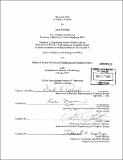| dc.contributor.advisor | Lee McKnight. | en_US |
| dc.contributor.author | Pearah, David E., 1973- | en_US |
| dc.contributor.other | Massachusetts Institute of Technology. Technology and Policy Program. | en_US |
| dc.contributor.other | Massachusetts Institute of Technology, Department of Electrical Engineering and Computer Science | en _US |
| dc.date.accessioned | 2005-10-14T19:26:27Z | |
| dc.date.available | 2005-10-14T19:26:27Z | |
| dc.date.copyright | 2001 | en_US |
| dc.date.issued | 2002 | en_US |
| dc.identifier.uri | http://hdl.handle.net/1721.1/29249 | |
| dc.description | Thesis (S.M.)--Massachusetts Institute of Technology, Engineering Systems Division, Technology and Policy Program, February 2002. | en_US |
| dc.description | Includes bibliographical references. | en_US |
| dc.description | Thesis (S.M.)--Massachusetts Institute of Technology, Department of Electrical Engineering and Computer Science, February 2002. | en_US |
| dc.description.abstract | Introduction: If the emergence of the World Wide Web was the communications and business phenomenon of the 1990' s, then the Mobile Web is already poised to be the darling of the next phase of the personal communications evolution. Consumers are already bombarded with a panoply of mobile communications products and services: wireless telephony, cellular handset mini-browsers, short message services, text paging. Driven by either personal or business habits forged on the traditional Internet, the perception is that consumers are increasingly turning to technologies that enable continuous or ad hoc information access in mobile situations, such as driving in a car or walking down the street. These technologies are primarily viewed as complements to, and not replacements for, the traditional modes of information access. As the name would suggest, the addition of the term "Voice Web" to the lexicon suggests yet another mode of mobile information access: speech interaction. While many of the technologies that support general speech recognition applications are hardly new, the consumer is infrequently exposed to anything more substantial than the most trivial of interactions, e.g. "Press or say '1.'" The relative anonymity of speech-interactive applications, coupled with the intoxicating (if not gratuitous) use of the term "Web," has created the perception that a new era of information access is about to dawn on the mobile consumer landscape, e.g. The Kelsey Group forecasts that by the year 2005, 45 million users will propel the voice market to $12 billion annually, more than $5 billion of which will be generated by advertising and commerce.2 The concern is not whether such estimations or projections are merited, but that the uncritical acceptance of the patently ambiguous Voice Web overlooks the multiplicity of dynamic forces that will come to bear on the evolution of the voice market in general. -- How does the structure of the historically vertically-integrated speech industry affect the evolution of the market? -- How will applications be accessed, e.g. democratic web of sites or carrier-specific private network? -- Are all the necessary technology platforms, networks, and standards in place to support the desired vision of the voice market? -- Who owns the direct relationship with the consumer, and how does service pricing affect both the quantity and quality of applications? -- What are the trademark issues involved in providing access to audio content already on the Internet, i.e. does a voice service provider need CNN's permission to play audio files freely accessible on the CNN website? -- What limitations does the telephony voice user interface impose on the application space? -- Ultimately, will the applications being proposed provide significant value for the consumer., thereby creating sufficient demand to seed further development? Given the complex interplay of the technological, economic, regulatory, and even human factors suggested above, the realization of the Voice Web concept is certainly not assured. As the opening quote from Dr. Meisel suggests, the pre-existence of the speech and Internet industries should not lull the reader into assuming that these two worlds will naturally merge into a single coherent and intuitive service model. While recent standardization efforts indicate a desire to extend the Internet service framework to voice applications, there has been little critical analysis of whether these technological innovations are sufficient to the task; moreover, other market factors (e.g. economics) are accorded little consideration in light of their potential impact on the evolution of the industry. For firms individually and the industry collectively, the success of the Voice Web ultimately depends on the anticipation of and appreciation for these interdisciplinary factors. This paper represents an attempt at a framework for both enumerating and negotiating these complex interrelationships, for the purpose of answering the following question: "Will a Voice Web model naturally arise from existing industry structures and market forces?" or conversely, "What is required to ensure the realization of the Voice Web?" | en_US |
| dc.description.statementofresponsibility | by David E. Pearah. | en_US |
| dc.format.extent | 255 p. | en_US |
| dc.format.extent | 12394987 bytes | |
| dc.format.extent | 12394788 bytes | |
| dc.format.mimetype | application/pdf | |
| dc.format.mimetype | application/pdf | |
| dc.language.iso | eng | en_US |
| dc.publisher | Massachusetts Institute of Technology | en_US |
| dc.rights | M.I.T. theses are protected by copyright. They may be viewed from this source for any purpose, but reproduction or distribution in any format is prohibited without written permission. See provided URL for inquiries about permission. | en_US |
| dc.rights.uri | http://dspace.mit.edu/handle/1721.1/7582 | |
| dc.subject | Technology and Policy Program. | en_US |
| dc.title | The Voice Web : a strategic analysis | en_US |
| dc.type | Thesis | en_US |
| dc.description.degree | S.M. | en_US |
| dc.contributor.department | Massachusetts Institute of Technology. Department of Electrical Engineering and Computer Science | |
| dc.contributor.department | Technology and Policy Program | |
| dc.identifier.oclc | 51724848 | en_US |
